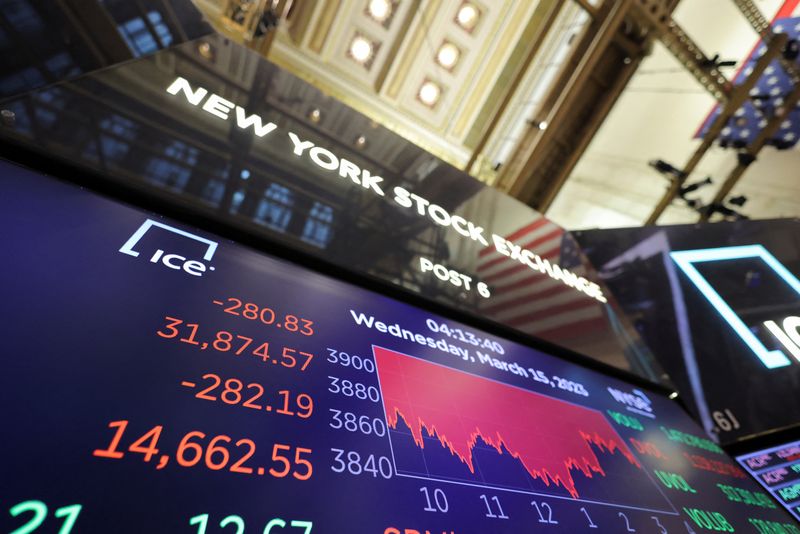By Saqib Iqbal Ahmed
NEW YORK (Reuters) - Investors are increasingly seeking insurance against a sudden crash in stocks, fearing that more tumult is in store for markets after worries over the banking system shook asset prices over the last week.
Various measures of perceived tail risk - the possibility of suffering large investment losses due to sudden or unforeseen events - have climbed to multi-month highs in recent days as concerns over contagion from the collapse of Silicon Valley Bank and instability at European bank Credit Suisse gripped markets.
The Nations TailDex, an options-based index that measures the cost of hedging against an outsized move in the SPDR S&P 500 ETF Trust (ASX:SPY), earlier this week rose to its highest level since May as banking worries percolated.
Such a move does not necessarily indicate a coming stock market crash but suggests that investors are worried about one, said Scott Nations, the index's creator and president of Nations Index Inc.
"It's a great insight into the amount of existential fear that a market has," Nations said.
The failures of Silicon Valley Bank and Signature Bank (NASDAQ:SBNY) and troubles at First Republic and Credit Suisse sent stock markets on a rollercoaster ride in the past week amid fears that another Lehman Brothers-style collapse may be looming. The S&P 500 is down 5% from its early February high though it remains up 3% year to date.
Regulators' efforts to backstop the U.S. bank failures and a $54 billion Swiss National Bank lifeline for Credit Suisse appeared to have allayed some concerns but sentiment remained fragile. Many investors fear more ructions may be in store in the banking sector or elsewhere, as the Federal Reserve's most aggressive monetary policy tightening in decades dries up cheap money and threatens to widen cracks in the global financial system.
"In general, this notion that there are real "tails" to the market is actually making a lot of clients revisit tail hedges," said Amy Wu Silverman, head of derivatives strategy at RBC Capital Markets, referring to options positions that would guard against big market losses.
More evidence of investor anxiety can be seen in the S&P 500 three-month skew, a measure of relative demand for upside versus downside options wagers that shows the highest demand for protection since May 2022, according to data from Susquehanna International Group.
"Back in October, the risk to the upside and downside tails were much more evenly distributed. ... Now the downside tail has a lot more risk priced into it," said Chris Murphy, co-head of derivatives strategy at Susquehanna.
BlackRock (NYSE:BLK), the world’s largest asset manager, was among those pinning the recent turbulence on the Fed’s monetary tightening campaign, which saw policymakers raise rates by 450 basis points over the past year.
Futures markets on Friday were pricing in a roughly 70% chance the central bank would raise rates by another 25 basis points at its March 21-22 meeting.
“The market gyrations of the past week are not rooted in a banking crisis, in our view, but rather are evidence of financial cracks resulting from the fastest interest rate hike campaigns since the early 1980s,” BlackRock analysts wrote on Thursday.
While markets have reduced their expectations for how high policymakers will raise rates following the uncertainty in the banking sector, “we think that’s misguided and expect major central banks to keep hiking rates in their meetings in coming days to try to rein in persistent inflation,” they said.
Dizzying gyrations in fixed income markets, which have dwarfed recent moves in stocks, are another source of investor unease, with some market participants concerned that the volatility in bonds will bleed into equities.
Swings in Treasury prices drove the ICE (NYSE:ICE) BofAML MOVE Index, a measure of expected volatility in U.S. Treasuries, to its highest levels since the financial crisis in the past week, following several days of wild moves that started after Silicon Valley Bank’s troubles became known.
Volatility in the Cboe Volatility Index, which reflects expectations of stock volatility, has been muted by comparison, though the index hit a five-month high earlier this week.

"Empirical work shows that in periods of stress, implied volatility also exhibits contagion-type characteristics, from one asset class to another asset class," said Kambiz Kazemi, chief investment officer at Validus Risk Management.
"That is something worth monitoring closely to gauge the expansion of risk within the system," he said.